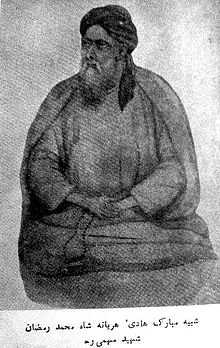Muhammad Ramzan

| Shah Muhammad Ramzan Mehami | |
|---|---|
| Born |
1769 Meham District Rohtak, Haryana,Punjab |
| Died |
1825 Madhya Pradesh |
| Occupation | preacher, tablighi |
Shah Muhammad Ramzan, Molvi Muhammad Ramzan Urdu شاہ محمد رمضان was a preacher and crusading tablighi in Haryana. He expressed by his preachings that the converted Rajputs, Meo and Jats (Muslim Rajputs) were in no way different from their Hindu counterparts in culture, customs and celebrations of religious festivals. He also defined by his preachings that they were not only pir-parast (Guru-worshippers) and grave worshiping (Qabr-parast); they were also idol-worshippers. They celebrated Holi, Diwali and other Hindu festivals with zeal and dressed in the Hindu fashion.[1][2][3][4]
Works as a reformer
"Hadi e Haryana" Hazrat Shah Muhammad Ramzan Shaheed Mehami was the prominent reformer of Haryana who typified this Da'wa. He made the Rajput Muslim conscious of their separate identity from Hindus. Shah Muhammad Ramzan used to sojourn in areas inhabited by such converted Rajputs, dissuade them from practising Hindu rites and persuade them to marry their cousins (real uncle’s daughters which converts persistently refused to do). They equally detested eating cow’s flesh. To induce them to eat beef, he introduced new festivals like Mariyam ka Roza and Rot-bot (on this eves, people observed on 17 Rajjab, a pao of roasted beef placed on a fried bread, was distributed amongst relatives and near and dear ones). Ramzan also encouraged such people to build mosques in large numbers, and to establish the wearing of Muslim dress and the observance of Islamic obligation. Waa'z (sermons) were employed as method of Da'wa. He opposed "taqlid" and firm believer of "Wahdat-ul-Wajood". Hindus also revered Hazrat Shah Muhammad Ramzan and in several Hindu villages there were "Shah Ramzan ke Chabutre" (raised platforms for Shah Ramzan). Such endeavours have ruled out the possibility of reconversion and have helped in the Islamization of neo-Muslims.[5][2][6][7][8][9]
.jpg)
Early life and death
He was born in Meham District Rohtak (Haryana) Punjab in 1769. His father Shah Abdul Azeem
( d 1828 Meham ) was Majzoob ( مجذوب )Sufi. His grand father Shah Abdul Hakeem (1709- 1773) was a notable Urdu writer of his time.[10][11]
Shah Muhammad Ramzan was dissatisfied with the Sufi religious system under his father Shah Abdul Azeem whose Rajput devotees present him with a tithe from every thing taken in their raids. Therefore at the age of fourteen he left his family to study with Hazrat Shah Abdul Qadir and Hazrat Shah Abdul Aziz Delhivi the sons of Hazrat Shah Waliullah. There he studied for fourteen years (1783-1796). He has worked as a preacher and tablighi throughout his life.[2][6]
Shah Muhammad Ramzan was killed by his co-religionist Bohras at Mandsaur in Madhya Pradesh when he was returned from "Hajj" on 18 January 1825.[12][2][7]
Scholarly work
He wrote in local language and dialects, sometime in the form of poems that could be recited and held debates with the scholars of other religious.[5]
- AQAID E AZEEM عقاہدء عظیم
- BULBUL BAGH E NABI ( Poetry ) بلبل باغ نبی
- AKHIR GUTT آخر گت
- Rangeeli ( Poetry )
- Waseet Nama
- Translation Qaseeda Amali
- Adab Chokra ( children education )
- Bohri Biaz
- Fatawa e Muhammadi (Poetry )
- Barq Laamaa Risala ( Poetry )
- Alim o Frayz Risala Ramzani
- Radd e Rawafiz Risala ( Persian )
His famous books "AQAID E AZEEM","BULBUL BAGH E NABI" And"AKHIR GUTT" are available on" Haryanvi Siddiqui" page Facebook.
References
- ↑ http://archive.org/search.php?query=creator%3A%22HAZRAT%20SHAH%20MUHAMMAD%20RAMZAN%20MEHAMI%22
- ↑ 2.0 2.1 2.2 2.3 https://archive.org/details/MATARALAJDAD
- ↑ http://voiceofdharma.org/books/tlmr/ch8.htm
- ↑ http://www.bharatvani.org/books/tfst/appi1.htm
- ↑ 5.0 5.1 Travellers in Faith: Studies of the Tablīghī Jamāʻat as a Transnational Islamic Movement for Faith Renewal
- ↑ 6.0 6.1 https://archive.org/details/HADIEHARYANA
- ↑ 7.0 7.1 https://archive.org/details/TazkiraEUlamayeHind
- ↑ https://archive.org/details/TazkiraESufiyaEMewat
- ↑ https://archive.org/details/FATAWAEAZIZI
- ↑ https://archive.org/details/UrduKiShakhHaryanviZubanMainTalifat
- ↑ https://archive.org/details/PunjabMeinUrduHafizMehmoodKhanShirani
- ↑ The Tabligh Movement or Millions of Bearded Militants on the March.
Further reading
- MATAR AL AJDAD (1964) by Prof:Manzoor-ul-haq Siddiqui
- Tazkira E Ulamaye Hind (November 1914) by Rehman Ali
- Urdu Ki Shakh Haryanvi Zuban Main Talifat (February 1932)by Hafiz Mehmood Sheerani
- Punjab Mein Urdu by Hafiz Mehmood Khan Shirani
- Tarikh E Zbane Urdu by Prof : Masoud Husain Khan
- HADI E HARYANA (October 1963) by Prof:Manzoor-ul-haq Siddiqui
- Tazkira E Sufiya E Mewat by Muhammad Habib ur Rehman Khan Mewati
- The Legacy of Muslim Rule in India by K.S. Lal
- TIME FOR STOCK TAKING ( The Tabligh Movement or Millionsof Bearded Militants on the March )by Sita Ram Goel
- Family Tree ( خاندانی شجرہ ) Compiled by Shafa Ullah Siddiqui